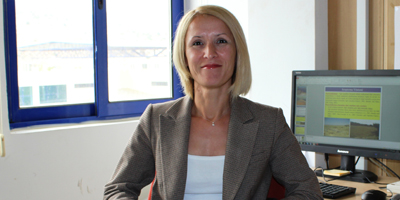EUL Academician Çiftçioğlu’s article published in “Environment, Development and Sustainability Journal”

Head of Department of Landscape Architecture- Faculty of Architecture of European Universty of Lefke- Assoc. Prof. Dr. Gülay Çetinkaya Çiftçioğlu’s article entitled “Determination of Basic Terrestrial and Marine Ecosystem Services Provided by Socio-Ecologically Active Terrestrial and Marine Landscapes in the Lefke Region of the Turkish Republic of Northern Cyprus” is published in the Science Citation Index Expanded (SCIE) database published in the Dutch refereed journal- The Journal of Environment, Development and Sustainability, published in the Netherlands.
Çiftçioğlu explained that the main research areas of Environment, Development and Sustainability Journal cover the environmental consequences of socio-economic development, sustainable development, sustainable development indicators, sustainable use of natural resources, complex relations between environment and development.
Çiftçioğlu said that socio-ecological landscapes, rich in biological and cultural diversity, formed as a result of mutual interaction between man and nature, offer many ecosystem services to local communities. Çiftçioğlu emphasized that the most detailed description of ecosystem services was made within the scope of the Millennium Ecosystem Assessment (2005) research project conducted by the United Nations in 2005 to assess the current state of global ecosystems.
The benefits of ecosystems to humans are classified into four groups
Çiftçioğlu said, “Ecosystem services represent the benefits of human ecosystems,”. Çiftçioğlu added that the benefits that ecosystems provide to humans are classified in four groups; There are supporting basic benefits such as food, water, fuel, air quality and climate regulation, and ecotourism benefits such as cultural, food production and water cycle.
Çiftçioğlu said that the TRNC has determined the basic ecosystem services provided by the local community in the Lefke Region in terms of socio-ecologically sustainable terrestrial and marine landscapes. To this end, local people’s resource values obtained from marine and coastal ecosystems such as terrestrial, wild plants, mushrooms, fish and sea salt are determined. Therefore, potential measures are being questioned in order to ensure the continuity of these resource values. Çiftçioğlu stated that the research method consists of two parts: modeling the relationship between the Lefke Region socio-ecological landscapes, basic ecosystem services and landscape planning, and determining the resource values of local people from terrestrial, coastal and marine ecosystems by following a participatory approach. Çiftçioğlu said she was involved in field work between December 2015 and March 2016 in 12 villages of the Lefke region and 106 local people (e.g, farmers, fishermen, wild plants and mushroom pickers) were interviewed within the scope of determining ecosystem resource values. Assessment of the obtained data revealed that the local people had collected 49 plants and 5 mushroom species from terrestrial ecosystems and 30 species of marine ecosystems for their own needs for various purposes such as alternative income, nature experience, socialization, learning local species.
Çiftçioğlu also stated that sea salt, citrus fruits and pine cones were collected to provide alternative income. As a result, the need and the importance of the national landscape planning strategy in the TRNC is questioned in order to ensure the continuity of the productivity and sustainability of the terrestrial and marine landscape in Lefke region.
